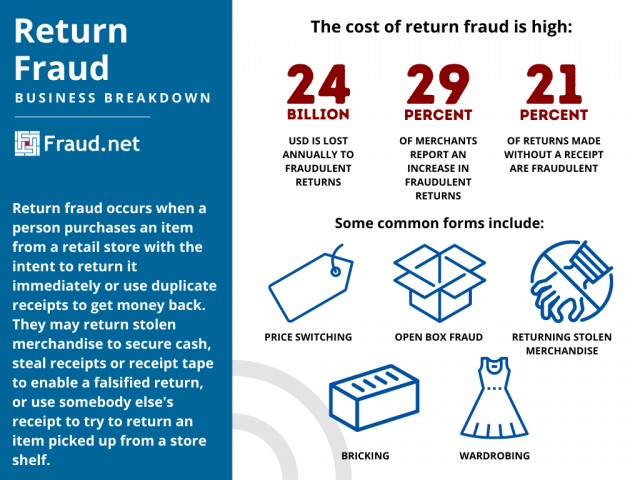What is Return Fraud?
Return fraud is an online scam that occurs when a person purchases an item from a retail store with the intent to return it immediately or use duplicate receipts to get money back. It is the act of defrauding a retail store via the return process. Fraudsters commit this crime in various ways. For example, the offender may return stolen merchandise to secure cash, steal receipts or receipt tape to enable a falsified return, or use somebody else’s receipt to try to return an item picked up from a store shelf.
There are several types of return fraud, including:
- Returning stolen merchandise – shoplifting and returning merchandise for a refund of the full price.
- Receipt fraud – stealing or falsifying receipts to return merchandise for profit. Another version of this is purchasing goods at a low price from one store and returning at another with a higher price to profit off the difference.
- Employee fraud – assistance from employees to return stolen goods for full price. This is a form of insider fraud.
- Price switching – placing higher price labels on merchandise to later return them at a higher price than the initial purchase. This is similar to profiting off the price difference in receipt fraud.
- Price arbitrage – purchasing similar-looking but differently priced goods, and returning the cheaper item as the expensive on and profiting off the difference.
- Switch fraud – purchasing a working item, and returning a damaged or defective item that was owned before the purchase of the working item.
- Bricking – purchasing a working electronic item, and stripping it of all valuable and necessary components to make it unusable, then returning it for profit.
- Cross-retail return – returning or exchanging an item purchased at another retailer for cash, store credit, or a similar, higher-priced item at another retailer.
- Open-box fraud – purchasing an item from the store and returning it opened with the intent to repurchase at a lower price under “open-box” store policies. This is similar to price-switching.
- Wardrobing – purchasing merchandise for short-term use with the intent to return the item (ex. purchasing a dress, wearing it for a night with the tags still on, and returning it).
The Cost of Return Fraud
The retail industry loses about $24 billion annually in return fraud and policy abuse, accounting for 8% of returns. In 2020, of the 10% of returned transactions, 6% were fraudulent, leading to a loss of $25.3 billion for retailers. As retail shifts online, 38% of merchants see an increase in buy online, return in-store purchases, and 29% of merchants report an increase in fraudulent returns among such transactions. Furthermore, 21% of returns made without a receipt are fraudulent. As a result, merchants often raise prices to offset losses, unfortunately affecting customer experience.
Holiday Shopping Seasons Increase the Risk
25% of annual product returns occur between Thanksgiving and New Years Day and return fraud increases during this time as well. According to the National Retail Federation, a quarter of holiday shoppers buy items with the intent of returning them later. This leads to merchants preparing for a large volume of returns. In 2018’s holiday season, about 10% of returns were expected to be fraudulent, leading to a loss of $6.5 billion in holiday return fraud. Due to high customer volume, sometimes loss and fraud prevention measures become more relaxed despite the increased vulnerability.
As a result of increased purchase and return volume, retail staff becomes overwhelmed with handling returns as well as investigating fraudulent ones. Often this leads to more staff being hired over the holiday season, increasing the merchant’s operating costs. If they choose not to or cannot hire more staff, the existing staff becomes overworked trying to keep up with the increased volume.
How to Prevent Return Fraud
Returns are necessary for retail to promote customer loyalty and satisfaction. Unfortunately, this poses a challenge for combatting return fraud. Policies must be clear and restrictive enough to effectively prevent return fraud, but flexible to avoid discouraging legitimate returns and exchanges. They also should be easy to access on online shopping sites and packaging/receipts for shipped goods.
In addition, as much data as possible must be collected from fraudulent returns to prevent repeat offenses and inform fraud prevention for future threats. Collective intelligence informed by transaction data helps fight future fraud by arming prevention and detection services.
Fight Return Fraud with Fraud.net
Fraud.net has a large suite of solutions helpful in fighting return fraud, among other types of fraud. With identity verification, dark web monitoring, and datamining services, fighting return fraud becomes easier and more efficient.
Contact us today for a free demo and recommendations to help you protect your profits from return fraud.





